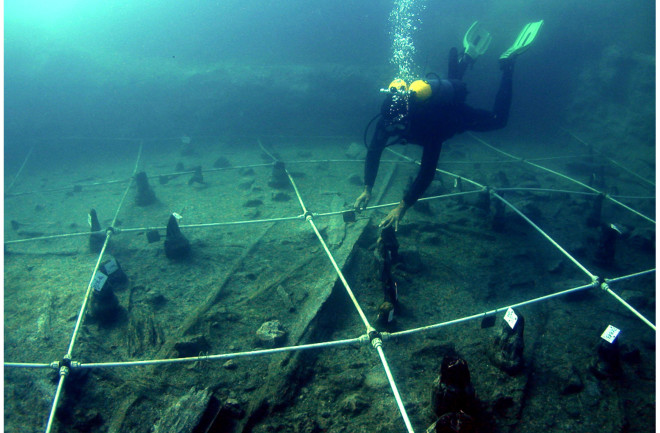You can tell a lot about a civilization from the way it built its boats.
An analysis of five canoes constructed over 7,000 years ago, found at the bottom of Lake Bracciono near Rome, highlights techniques that indicate a well-organized society with specialists. Some details also hint that residents of the Neolithic lakeshore village of La Marmotta possessed navigation skills, according to a report in PLOS ONE.
Niccolò Mazzucco, an archaeologist from the University of Pisa, studied the boats. “These societies were far from rudimentary but possessed a technical complexity and level of thought comparable to our own,” said Mazzucco in an email interview.
Read More: The Viking Longship: An Engineering Marvel of the Ancient World
Several elements transformed these boats beyond rudimentary dugouts, Mazzucco added. They were constructed with multiple types of wood, reinforced in key places, and featured adaptations that might have allowed for sails or outriggers.
Building Better Boats
Although one type of tree dominated the region where the boats originated, their builders used wood from four types. That suggests specialized skills because each wood type has different traits. “Boat-builders possessed enough knowledge about the qualities of the wood available, and they knew exactly which trees could be used to make the dugouts,” Mazzucco said. Most boats found at other Neolithic sites used one type of wood.
Supports that stretched across the width of the canoe were one notable specialized part — a part not found in other Neolithic boats found thus far. Those reinforcements help boats maintain their shapes, preventing warping or splitting. The supports also distribute the weight more evenly, making the canoes strong enough to carry heavy loads.
Read More: What was the Neolithic Revolution, and How Did It Change Human Societies?
The archaeologists also linked some tools found at the site to the canoes’ construction. They demonstrate that polished stone adzes found nearby helped shape the watercraft. Marks on the wooden boats were consistent with microscopic wear patterns on the adzes’ surfaces.
Sophisticated … and Seaworthy?
Perhaps the most enigmatic canoe featured three T-shaped wooden objects with a series of holes in each. These findings were tantalizing, Mazzucco said because they hinted at a jump from simple dugout to more complex watercraft — perhaps to sailboat or outrigger. The holes were likely present to attach one of those devices to the boat. “Such advancements suggest a deeper comprehension of maritime technology and navigation, with vessels equipped for long-distance voyages,” Mazzucco said.
Those details, plus the lengths of the boats — one as long as 36 feet — provide “irrefutable proof” that they were intended to sail in the Mediterranean Sea, because that size seems excessive for travelling a relatively small inland lake where both sails and outriggers would also be unnecessary. The authors posit that the boats could have reached the sea by floating about 23 miles down the River Arone.
By doing so, the Neolithic boats may have helped spread agriculture around the Mediterranean coast. Mazzucco predicts that more boats found throughout the area will confirm his prediction. He and his team will continue to search for more, as well as create, then sail, replicas of the Marmotta boats.
Read More: Do We Know When Ancient Humans First Built Boats?

